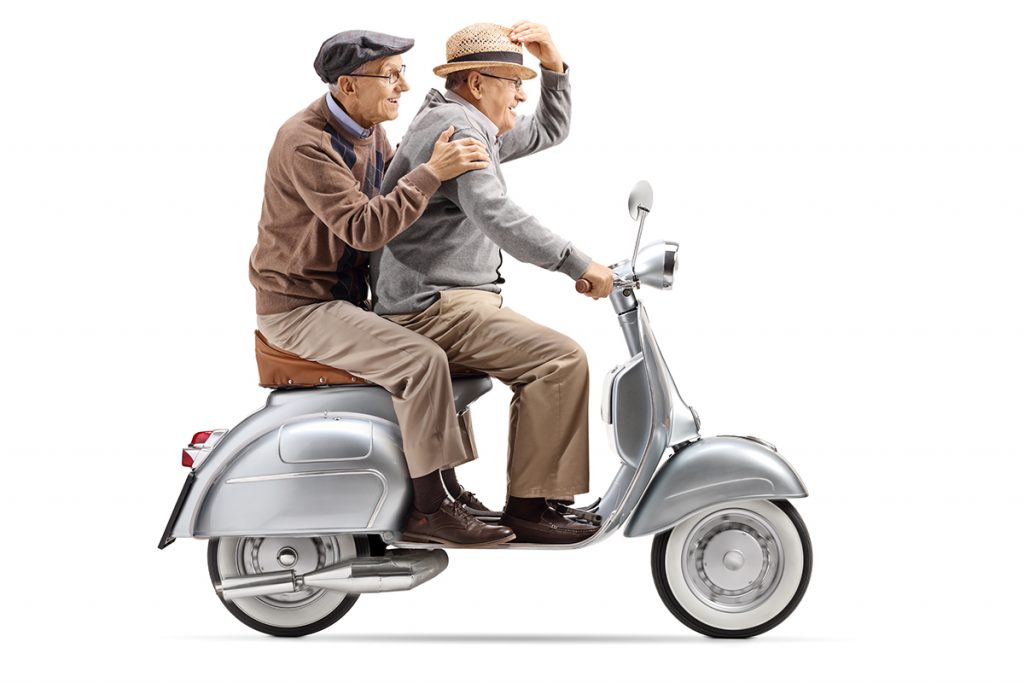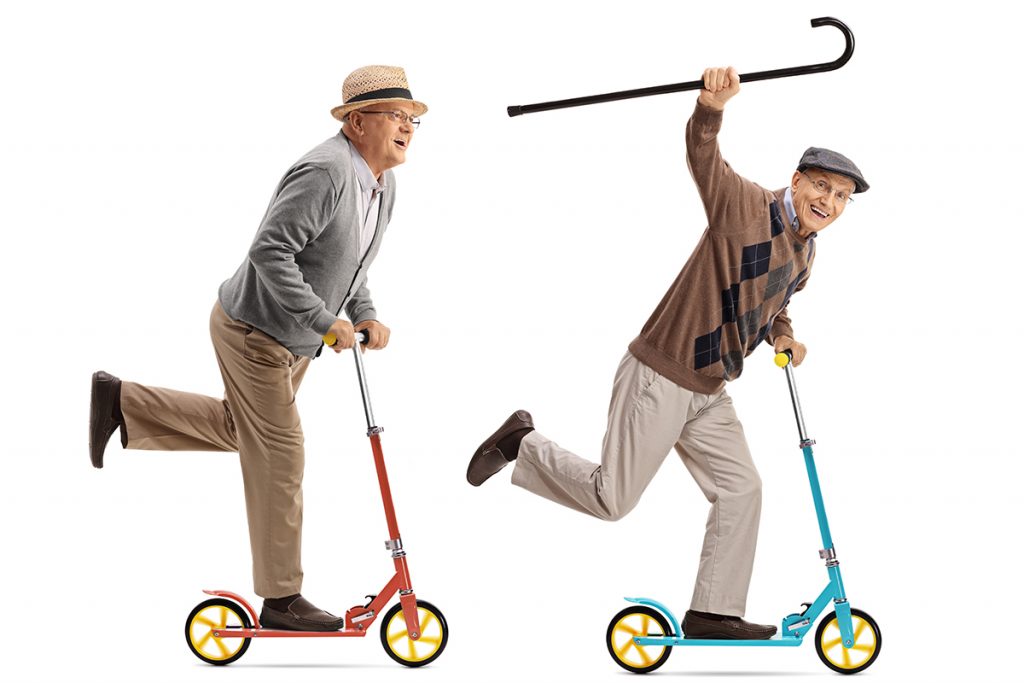
I remember the day my dad hung up his car keys for the last time. He didn’t share specific details with me, but he knew the time was right. Years later, he still recalled it as one of the most difficult decisions of his life. The loss of independence and control stuck with him as an offense greater than most other indignities he suffered as his Parkinson’s symptoms advanced. Driving not only gets us where we need to go, but it affords us the privilege of arriving under our own power and by our own devices. All of us want to stay behind the wheel for as long as possible, but the key is to do so safely.
Rita Morrow and Tihisha Rawlins of AARP and Lynda Lambert of AAA offer some tips and strategies that keep us more comfortable with driving as we age.
What can you do to be safer on the road and more comfortable with driving?
The main components to consider for safe driving include vision, reaction time, and mobility. Each of these can be improved with regular maintenance and attention. Here are a few suggestions from Lynda and Rita:
- Get regular eye exams. “The amount of light needed to drive doubles every 13 years,” Lynda says. AAA recommends eye exams every two years for those aged 60 and younger and every year for those 61 and over.
- Work on your neck mobility. To drive safely, you must be able to look in all directions. Stay flexible by turning your head from side to side periodically through the day.
- Stay alert. “If you look away for even two seconds, you double your chances of an accident,” Lynda says. Keep track of what’s happening in front of, behind, and on both sides of your vehicle. Take note of what’s happening 20-30 seconds down the road.
- Give yourself more time to react. The time we need to process information can be a bit longer as we age. A general rule for all drivers is to maintain a 3-second following distance from the car ahead of you.
- Ease your worries. If you are uncomfortable on highways or bridges, plot your route ahead of time and make adjustments. If left turns make you nervous (they do increase the chances for an accident), make three right turns to avoid that left. In other words, go around the block.
- Stay mentally and physically fit. “Don’t sit down and give up,” Lynda says. AAA advises physical exercise for 20 minutes daily/five days a week. Do something you enjoy like gardening, golf, or tennis. Keep your mind active with crossword puzzles or learning something new.
- Know your medication’s side effects. Prescriptions and supplements can affect you in unexpected ways. Read the fine print and talk with your doctor. If you feel sleepy or disoriented, don’t drive. Check out the Roadwise RX program below.
- Avoid distractions. Stay off your phone and eliminate the radio if it proves troublesome. Be mindful of children darting in front of traffic to chase a ball or people crossing the street. Even those beautiful grandchildren in the backseat can cause us to take our eyes from the road if we’re not careful.
How do you know when it’s time to hang up your keys?
Even with these options and strategies, there will come a time when driving is no longer the best idea. “Chronological age is not a predictor,” Lynda says. “What counts is performance, as well as physical and mental fitness.” It may be obvious when the time comes, but Lynda and Rita offer a few signs of diminished capacity that may indicate it’s time to turn in the keys. Ask yourself the following questions:
- Have I had a series of minor crashes?
- Are there dings and dents on my vehicle that I can’t explain?
- Do I get lost more often or fail to recognize once-familiar roads?
- Am I unable to read or understand road signs?
- Are other drivers honking at me frequently?
- Have family and friends, or even police officers, talked to me about my driving?
Even when the day arrives, take heart. The inability to drive no longer means staying home or being dependent on a family member. “I used to tell my daughter that she could hire me a driver to be at my disposal,” Rita says. “But now, I know I will just call Uber or buy a self-driving car. It’s not going to slow me down.”

PROGRAMS TO HELP
CarFit Program: CarFit is a collaboration among AAA, AARP, and AOTA (American Occupational Therapy Association), where drivers work with trained advisors to assess essentials such as being able to reach for the seatbelt, adjusting mirrors, and maintaining a proper distance of 10 inches away from the steering wheel. “Drivers may be hesitant to attend one of these sessions because they believe the goal is to label them as unfit drivers. The opposite is true. CarFit focuses on helping drivers to stay on the road by making sure their vehicle truly fits their current needs,” Lynda says. Call your local AAA or AARP branch to find locations for an upcoming CarFit event.
AARP Driver Safety Program: AARP’s Driver Safety program operates with either an in-person or online class option. No portion of the class takes place in a car; the focus is primarily on reminders about driving safely and on recent changes that may have taken place in the law or on local roads. Anyone over the age of 55 can take the class, and some insurance companies offer discounts to those drivers who have completed it. (Check with your insurance agent to find out if a discount is available for you.) “People may or may not learn something new from the class, but 97 percent of them say they come away with at least one thing they will change to improve their driving,” Rita says.
RoadwiseRX.com: This website was developed by the AAA Foundation for Traffic Safety and is a great resource for anyone who takes prescription or over-the-counter medicine or nutritional supplements. Simply enter the name of the product and you will see information about side effects that might impact your driving ability.
ARE THERE ANY TOOLS TO MAKE THINGS EASIER?
Newer cars have helpful technology that benefits drivers of all ages. If a driver veers out of the lane or doesn’t keep hands on the steering wheel, the wheel vibrates. When using cruise control, the car can automatically slow when approaching another car. (Just don’t use cruise in the rain; your car may skid.) Side mirrors can signal when it’s not safe to change lanes.
Other inexpensive items that can be purchased and easily added to the car include visor extenders that protect from sun and glare; side mirrors that help address blind spot concerns; seat belt extenders that improve mobility; and steering wheel covers that protect from extreme temperatures.
Additional adaptive devices can be purchased and installed by professionals. Those include pedal extenders, seat lifts, and support cushions to name a few. It is best to talk these options through with AARP or AAA advisors, or even your favorite mechanic or car dealership.
By Megan S. Willman
[…] P.S. Should you keep driving? […]